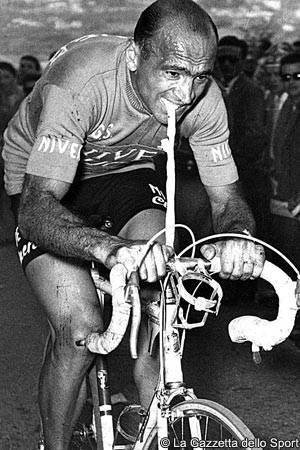103 years of history rated by a panel of 100 journalists to exorcise 12/12/12
 Giro d’Italia organiser RCS Sport has put together a ‘Universal Classification’ of the first 103 years of the race, to “exorcise the World’s end, as predicted by the Mayan Prophecy.” Polling a list of 100 journalists, RCS Sport has put together the most popular choices, with the city of Trieste, Fausto Coppi, Gino Bartali, Andy Hampsten, Felice Gimondi, Fiorenzo Magni, Marco Pantani, Eddy Merckx and Carlo Clerici providing some of the most memorable, heroic and iconic moments of the Giro’s history.
Giro d’Italia organiser RCS Sport has put together a ‘Universal Classification’ of the first 103 years of the race, to “exorcise the World’s end, as predicted by the Mayan Prophecy.” Polling a list of 100 journalists, RCS Sport has put together the most popular choices, with the city of Trieste, Fausto Coppi, Gino Bartali, Andy Hampsten, Felice Gimondi, Fiorenzo Magni, Marco Pantani, Eddy Merckx and Carlo Clerici providing some of the most memorable, heroic and iconic moments of the Giro’s history.
The most dramatic moment of the Giro was voted as the stage between Rovigo and Trieste during the 1946 race. Coming less than a year after the end of World War II, anti-Italian activists wanted the city to be part of the newly created country of Yugoslavia, and they managed to stop the race – with cement blocks in the road, and throwing rocks and nails at riders – 2km east of the village of Pieris, still some 40km short of the finish.
The race organisation declared the stage end at Pieris, and neutralised the day’s general classification, but some riders – led by Trieste born Giordano Cottur – insisted on riding into Trieste regardless.
The three most popular ‘best Giro d’Italia’ were won by Coppi, Hampsten and Pantani. The 1949 race saw Coppi take an epic stage victory between Cuneo and Pinerolo with a 192km solo attack. Despite the start and finish towns being just 60km apart, the day’s route took the race over the Colle della Maddalena, the Col de Vars, Col d’Izoard, Col de Montgenèvre and Sestriere. Coppi finished 11’52” ahead of Bartali, taking the pink jersey from Adolfo Leoni, and keeping it all the way to the finish.
Hampsten’s 1988 victory saw him take the pink jersey on one of the most iconic stages of the race’s recent history, as he rode over the 2621 metre Passo di Gavia in a blizzard. Dutchman Erik Breukink took the stage, but Hampsten took the race lead and never gave it up. Pantani’s 1998 victory saw the late ‘Pirata’ overcome challenges from Russian Pavel Tonkov and Swiss Alex Zülle to take the first part of what was to be a Giro-Tour double that year.
Coppi’s Pinerolo exploit was also voted the best stage victory of all time; he, Bartali, and Felice Gimondi were voted as the champions that “truly represented the values of the Corsa Rosa;” unsurprisingly, the greatest rivalry was that between Coppi and Bartali.
The most iconic image from the Giro’s history was voted as that of the recently departed Fiorenzo Magni, riding the Mountain Time Trial of Bologna-San Luca, in the 1956 race (pictured). The three-time winner, and defending champion, had fractured his collarbone in a crash the day before, and was unable to pull the bars; his mechanic Falerio Masi suggested tying a tubular tyre to his bars, which Magni gripped between his teeth.
The most poignant gesture of sportsmanship in the Giro came on the fourth stage of the 2011 race, when the entire peloton rode the 216km route between Quarto dei Mille and Livorno in tribute to Belgian Wouter Weylandt, who had tragically died the day before. The rest of Weylandt’s Leopard Trek team, along with his close friend Tyler Farrar of Garmin-Cervélo, crossed the line together in one of the most poignant images ever from the race.
Rai radio commentator Mario Ferretti was voted to have come up with the most legendary statement from the race; again from Coppi’s Cuneo to Pinerolo exploit, Ferretti said, at the beginning of his programme: “There’s only one man in the lead: his jersey is celeste and white; his name is Fausto Coppi.”
Swiss rider Carlo Clerici was voted as the biggest surprise winner in the race’s history; starting the 1954 race as domestique to Hugo Koblet, Clerici took the race with a fluke attack, from which the Italian press coined the phrase “fughe bidone”, which has entered the cycling vocabulary. He managed to take more than half an hour which, despite Clerici not being a great climber, the rest of the peloton was unable to pull back.
In the 103 years of the Giro d’Italia, the three most impressive sporting feats were, in reverse order: Coppi’s Pinerolo victory again; Marco Pantani’s victory in Oropa in the 1999 race, despite suffering a mechanical at the foot of the final climb; but the most impressive feat in the race’s history, was Eddy Merckx’ victory in Tre Cime di Laveredo in 1968, where he seized the pink jersey back from Michele Dancelli on the mythical climb – which will be the final climb of the 2013 race – and went on to take the first of his five Giro victories.
Click on the first picture below for a gallery of iconic images from the Giro’s 103 year history